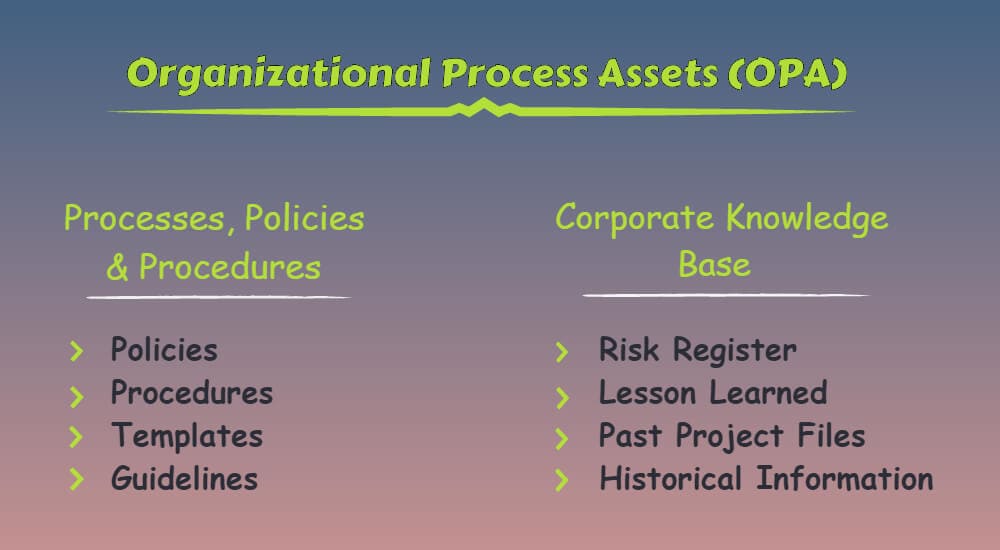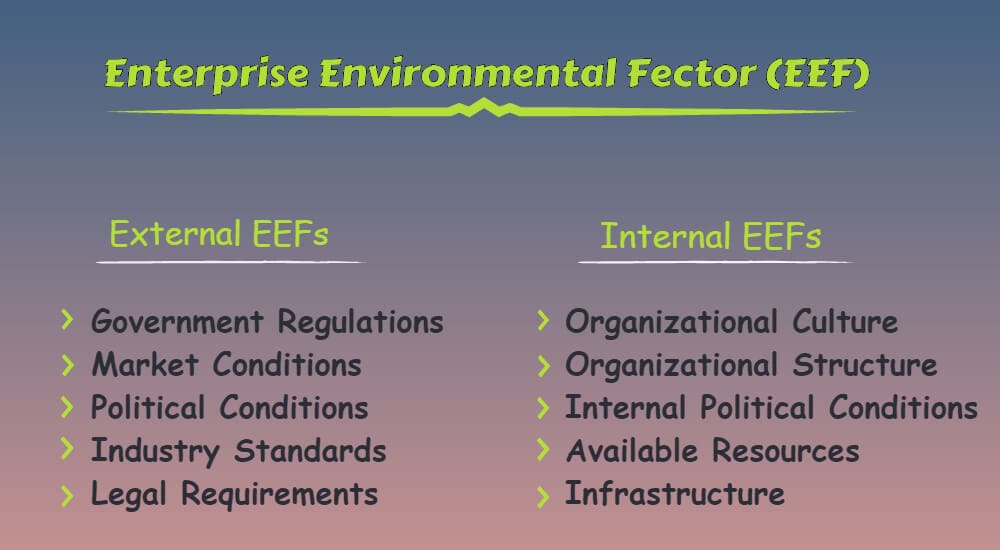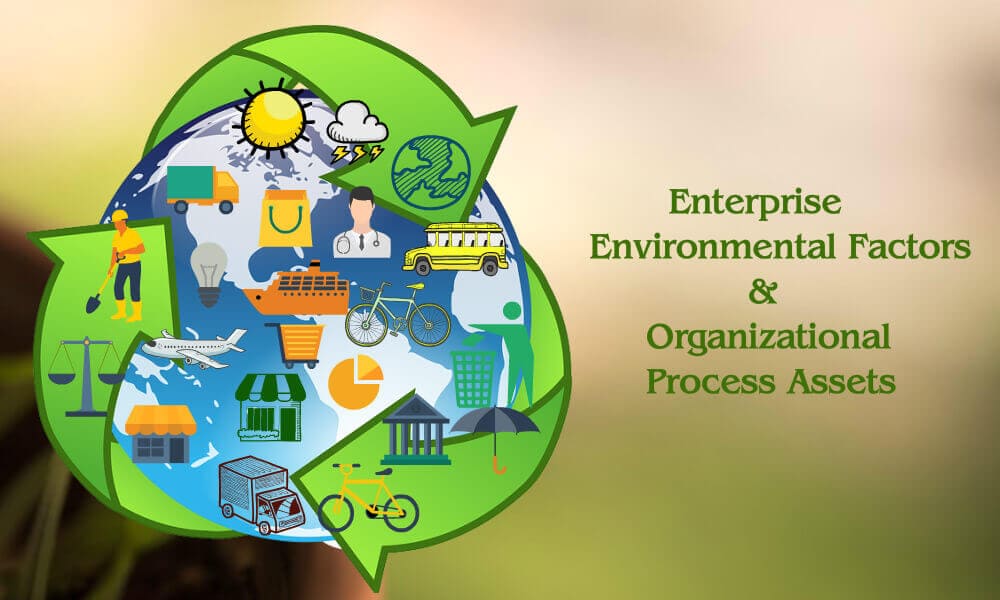Organizational Process Assets (OPA) and Enterprise Environmental Factors (EEF) are listed as “influences” in the PMBOK Guide.
They are termed as such because they influence a project, and are both an input and output of many processes. A solid understanding of these concepts is an important part of your preparation for the PMP exam.
OPA and EEF have extensive uses in project management; therefore, the PMI has explained these concepts thoroughly in the PMBOK Guide. However, I have found that some elements require more clarification.
In this blog post, we will discuss both Organizational Process Assets and Enterprise Environmental Factors in detail and then look at issues regarding these influences.
Let us start with OPA.
Organizational Process Assets (OPA)

The PMBOK Guide defines Organizational Process Assets as follows:
“Plans, processes, policies, procedures, and knowledge bases that are specific to and used by the performing organization.”
These accumulated repositories help an organization manage future projects.
Examples of OPA
The following are a few examples of OPA:
- Lessons learned
- Historical records
- Policies
- Procedures
- Project templates
- Knowledge bases
Historical records include records from previous projects like risk registers, stakeholder registers, checklists, project plans, issue logs, and performance reports.
You cannot update or modify these processes, policies, and procedures because the Project Management Office (PMO) or any other higher authority develops them. However, you can slightly modify templates according to the needs of your project.
Types of OPA
OPA can be divided into two categories:
- Processes, policies, and procedures
- Organizational knowledge bases
Some examples of processes, policies, and procedures are templates for any plans, documents, procedures to carry out work, or any guidelines you have developed.
You can update or add to an organizational knowledge base anytime you wish, and you are encouraged to do this so future projects can benefit from your experience.
Some examples of organizational knowledge bases are lessons learned, old project files, financial databases, etc.
Enterprise Environmental Factors (EEF)

The PMBOK Guide defines EEF as follows:
“Conditions, not under the immediate control of the team, that influence, constrain, or direct the project, program, or portfolio.”
EEF are the environments under which you will have to work. You have no control over these factors, and they can be favorable or detrimental influences on your project. Most of the time, EEF are seen as constraints.
Although EEF can be an input of all processes, their role is prominent in the planning processes. To complete your project successfully, you must understand EEF to minimize obstruction.
For example, you cannot break the law or circumvent regulation and hope your actions will not influence your project.
Examples of EEF
The following are a few examples of EEF
- Rules and regulations
- Organizational culture
- Political environment
- Industry standards
- Work authorization system
- Human resource skills
Types of EEF
EEF can be divided into two categories: Internal EEF and External EEF.
Internal EEF is imposed by the organization on your project. Some examples of internal EEF are resource availability, resource capability, PMIS, organizational culture, organization structure, and code of conduct.
External EEF are outside factors affecting the organization and your project. Some examples of external EEF are political conditions, marketplace conditions, governmental regulations, and commercial databases.
OPA vs EEF
Now that you understand OPA and EEF, it’s time to look deeper into their differences. . Both are used in all aspects of a project, and provide support and a controlled environment in which to execute the project.
Let us have a look at a few differences between OPA and EEF.
- EEF is not under the control of the project management team, and the team has to abide by them. OPA is under their control but are not mandatory to follow.
- All project management processes are affected by EEF, but they do not change EEF. OPA is used by the processes and can be modified and updated when required.
- EEF impose limitations on the project, and sometimes managing them is difficult. OPA help you run the project and they rarely impose any restrictions.
- It is challenging to change any EEF and most of the time, you have to follow them. On the other hand, you can modify OPA as you wish. OPA are always updated as you continue to get new knowledge and learn new lessons.
- EEF can be either internal or external to an organization, while OPA are always internal.
Why are PMIS and Work Authorization Systems EEF, not OPA?
I have been asked countless times why Project Management Information System (PMIS) is an EEF and not OPA as it is bought, customized, and used by the organization itself.
Please note that, although your organization uses PMIS, you cannot change it. You have to align your processes according to the system and use it for your benefit. The reports and documents generated by PMIS are OPA, but the PMIS itself is an EEF.
Likewise, Work Authorization Systems are also EEF, as they are defined at an organizational level and you do not have any control over them. You have to follow them. The Work Authorization System is a subsystem of PMIS.
Discrepancies in the PMBOK Guide
I have received many emails from PMP aspirants regarding some discrepancies in the PMBOK Guide about OPA and EEF.
Some elements appear in OPA as well as in EEF. This made professionals think that the PMBOK Guide has some discrepancies regarding the OPA and EEF. Although there can be discrepancies, I believe it is not the case. The project management environment is dynamic, and there are many grey areas; therefore, we have to look at each discrepancy on a case-by-case basis.
For example, any organizational policy or procedure can be an EEF, but if you create a policy or procedure specific to your project, then it will be an OPA.
Summary
OPA and EEF are two forms of influence on the project. Although EEF can sometimes act as constraints, they are for the greater good of the project, organization, and the community. For example, regulations regarding pollution or noise control are a constraint imposed on your project but they are for the greater good.
You must have a firm understanding of these factors when managing your project as they provide you with the environment and necessary knowledge base. You have to follow EEF and use OPA, and contribute to the knowledge base as well, so future generations can benefit from it.
How OPA and EEF influence your project? Please share your comments in the comments section.

Amazing… I have almost completed my preparation for PMP exam, looking for a good stimulator, is there anything, which will be good with economical price.
You can try whizlabs simulator. It is the cheapest one.
Excellent! Well-written article!
Thank you Kalsum.
Dear Fahad,
Thank you for the great article. Could you please explain Internal EEF will also not come under PMT. ? I have read some books External EEF are not under control of PMT. Kindly provide more information if possible.
Many thanks.
Kind regards,
booraj
Can a project management team change the law or a government regulation?
No, they cannot. Therefore, external EEFs are not under control of project management team.
Thank you!.. after reading the article, I can clearly understand the difference between OPAs and EEFs
You are welcome Maria.
It Is a really good article, many thanks Fahad.
Good article showing in depth knowledge of the author. Very informative. Thanks
Clear and crisp artical. Thanks.
very good
thanks
Excellent, well explained
I must say after reading this i now understand.
You have done a great job by breaking this down in a very simple form.
Thank You.